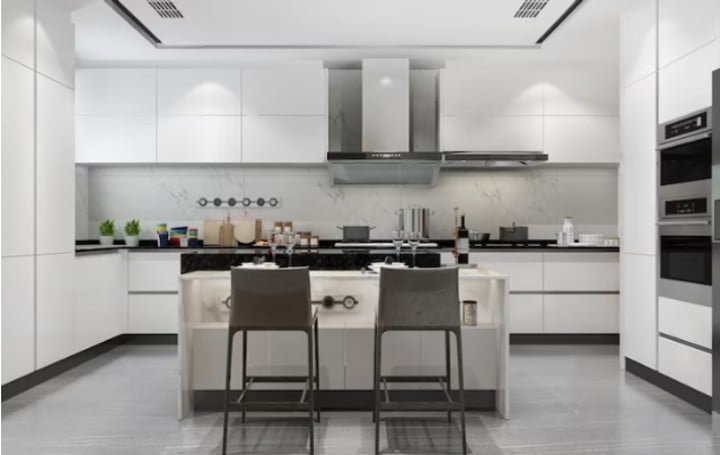
The kitchen is often considered the heart of a home, a space where family and friends gather to share meals and create lasting memories. However, a disorganized and cluttered kitchen can turn this central hub into a source of frustration and stress. Explore the journey from chaos to order, offering practical tips on organizing your kitchen effectively. From optimizing kitchen layouts to utilizing the best kitchen design software, we’ll cover various aspects that contribute to a functional and aesthetically pleasing culinary space.
Assessing Your Space
Before diving into the organizational process, it’s essential to assess your kitchen space thoroughly. Consider the size, layout, and existing storage solutions. Take note of any areas that are underutilized or present challenges in terms of accessibility. This initial assessment will serve as the foundation for creating a personalized and efficient organization plan.
Kitchen Layouts
One of the key factors influencing the functionality of your kitchen is its layout. Whether you have a galley, L-shaped, U-shaped, or open-concept kitchen, each layout comes with its own set of advantages and challenges.
- Galley Kitchen: Characterized by parallel countertops and a central corridor, galley kitchens are efficient for small spaces. Maximize this layout by installing shelving on unused walls to store pots, pans, and utensils. Consider vertical storage solutions to make the most of limited space.
- L-Shaped Kitchen: Featuring countertops along two adjacent walls forming an “L” shape, this layout provides ample counter space. Utilize the corner efficiently with pull-out shelves or rotating carousels to access pots, pans, and ingredients stored in the back easily.
- U-Shaped Kitchen: Offering three walls of cabinets and countertops, U-shaped kitchens maximize storage potential. Ensure an organized workflow by grouping similar items together, such as placing cooking utensils and pots near the stove. Consider installing pull-out drawers for easy access to items stored in lower cabinets.
- Open-Concept Kitchen: Popular in modern homes, open-concept kitchens seamlessly blend with the adjoining living or dining areas. Maintain a cohesive design by incorporating multifunctional furniture and storage solutions that complement the overall aesthetic of the space.
Utilizing the Best Kitchen Design Software
In the digital age, technology plays a crucial role in home improvement projects. The best kitchen design software can be a valuable tool in visualizing and planning your kitchen organization before making any physical changes. These software options offer features such as 3D modeling, virtual walkthroughs, and detailed measurements, empowering you to experiment with different layouts and configurations.
- IKEA Kitchen Planner: Ideal for those considering IKEA products, this user-friendly software allows you to design your kitchen with IKEA cabinets and accessories. It provides a realistic 3D view of your space, helping you make informed decisions about layout and storage solutions.
- Cedreo: A comprehensive design tool that goes beyond just kitchens, Cedreo enables you to visualize your entire home. With its intuitive interface, you can experiment with various kitchen layouts, flooring options, and color schemes to create a cohesive design.
- 2020 Design: This professional-level software is widely used by interior designers and kitchen professionals. 2020 Design offers advanced features, including a vast catalog of appliances, fixtures, and materials. It provides detailed renderings to give you a realistic preview of your redesigned kitchen.
Decluttering and Categorizing
Once you have a clear understanding of your kitchen space and a preliminary design using the best kitchen design software, it’s time to declutter and categorize your belongings. Start by emptying cabinets, drawers, and pantry shelves to assess each item’s necessity and condition.
Decluttering
The Rule of Three: If you haven’t used an item in the last three months and can’t foresee using it in the next three, it may be time to let it go. Donate or discard duplicate or seldom-used utensils, gadgets, and cookware.
Expired Goods: Check expiration dates on pantry items and spices, disposing of anything past its prime. Take this opportunity to organize your pantry by grouping similar items together and labeling shelves for easy identification.
Categorizing
Zones and Categories: Organize your kitchen into zones based on functionality, such as cooking, baking, and prep. Within each zone, further categorize items. For example, create a baking zone with categories like flour, sugar, baking powder, and mixing bowls grouped together.
Drawer Dividers and Organizers: Invest in drawer dividers and organizers to keep utensils, cutlery, and kitchen tools neatly separated. This not only facilitates easy access but also prevents clutter from accumulating in drawers.
Optimizing Storage Solutions
With a decluttered and categorized kitchen, the next step is to optimize storage solutions to make the most of your available space. Consider incorporating a mix of traditional and innovative storage solutions tailored to your kitchen’s layout and your specific needs.
Cabinet and Drawer Upgrades
Pull-Out Shelves: Replace traditional shelves with pull-out shelves to make items at the back of cabinets easily accessible. This is especially beneficial for lower cabinets, where reaching deep into the space can be challenging.
Lazy Susans: Ideal for corner cabinets, lazy Susans maximize storage by providing a rotating platform for pots, pans, and pantry items. This eliminates the need to rummage through the depths of the cabinet to find what you need.
Vertical Dividers: Organize baking sheets, cutting boards, and trays with vertical dividers in cabinets. This prevents items from stacking haphazardly and makes it simple to grab what you need without disturbing the rest.
Overhead Storage
Hanging Pot Racks: Free up cabinet space by hanging pots and pans from a ceiling-mounted rack. This not only adds a decorative element to your kitchen but also keeps your most-used cookware within arm’s reach.
Floating Shelves: Install floating shelves above countertops or in empty wall spaces to display decorative items or store frequently used ingredients. This adds a touch of style while maintaining functionality.
Personalizing Your Kitchen
Beyond the functional aspects of organization, personalizing your kitchen adds a unique touch that reflects your style and preferences. Consider incorporating design elements and accessories that enhance both the aesthetics and functionality of your culinary space.
Decorative Storage Containers
Glass Jars and Canisters: Transfer pantry staples like flour, sugar, and pasta into transparent glass jars or canisters. Not only does this create a visually appealing display, but it also allows you to quickly assess when it’s time to restock.
Color-Coordinated Accessories: Choose kitchen accessories and linens in colors that complement your overall design scheme. This simple touch can tie the room together and create a cohesive and inviting atmosphere.
Greenery and Natural Elements
Indoor Herb Garden: Bring nature into your kitchen by cultivating an indoor herb garden. Not only do fresh herbs add flavor to your dishes, but they also serve as a decorative element.
Natural Light: Maximize natural light by choosing window treatments that allow sunlight to flood the space. Well-lit kitchens not only feel more inviting but also make it easier to work efficiently.
Maintenance and Sustainability
Maintaining an organized kitchen is an ongoing process that requires regular attention and upkeep. Implement sustainable practices to reduce waste and promote an eco-friendly kitchen environment.
Regular Maintenance
Weekly Check-Ins: Dedicate a few minutes each week to assess the organization of your kitchen. Return items to their designated places, check for expired goods, and make adjustments as needed.
Rotating Stock: Practice the “first in, first out” rule for pantry items to ensure nothing goes to waste. When restocking, move older items to the front, so they are used before newer purchases.
Sustainable Practices
Reusable Containers: Opt for reusable containers for food storage instead of disposable options. Glass or stainless steel containers are not only environmentally friendly but also durable and easy to clean.
Composting: Set up a composting system for kitchen scraps to reduce the amount of waste sent to landfills. Compost can be used to enrich soil for your indoor herb garden or outdoor plants.
Conclusion
Transforming your kitchen from chaos to order involves a thoughtful combination of practical organization strategies, personalized touches, and the use of technology such as the best kitchen design software. By assessing your space, decluttering and categorizing, optimizing storage solutions, personalizing your kitchen, and maintaining sustainable practices, you can create a culinary haven that is not only efficient but also a joy to spend time in. Remember, the key to a well-organized kitchen is a balance between functionality and aesthetics, making it a space where cooking and gathering become seamless and enjoyable experiences.
We hope you found this blog post on From Chaos to Order: Organizing Your Kitchen, useful. Be sure to check out our post on The Best Kitchen Storage Ideas for an Organized Kitchen for more great tips!
Have Experience in the Moving Industry? Want an Additional Income Stream? Work With All Around Moving!
All Around Moving’s Work With Us program helps you profit. Earn extra income while applying your knowledge in the moving industry. Click here to learn more.





